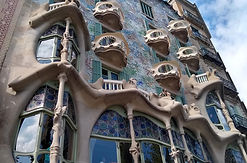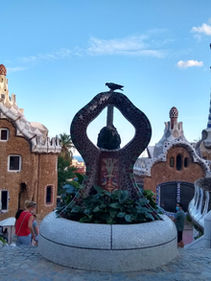
ART NOUVEAU (Modernisme)
Spain
As a famous art style that dazzled many countries, Art Nouveau was mainly displayed in architecture and the visual arts at the end of the nineteenth century and the beginning of the twentieth century. A particular ideology accompanied this artistic movement, which is rooted in complex historical pathways and traditions and is strongly influenced by the romantic tradition, where ancient cultures, idealism and exoticism combined to make a totally new form of art.
The manifestation of Art Nouveau (or Catalan Modernism) in Barcelona contributed to a unique period in the city's history where artistic effervescence ran parallel to economic expansion and the demolition of the city's original medieval walls. The new bourgeoisie needed to align itself with modern Europe by means of exposing their wealth and power through the expression of art. The organisation of two Universal Exhibitions in Barcelona (in 1888 and 1929) was not isolated from the need to showcase the emergence of this new artistic movement, particularly in the fields of architecture and the fine arts. Thus, the rise of Art Nouveau in Barcelona developed simultaneously with the development of a new society and distribution of social power.
Art Nouveau artists usually specialised in one creative field but were also able to perform in other artistic disciplines outside their own. From well-known architects such as Gaudí or Domènech i Montaner to painters like Casas, Opisso or Nonell; sculptors such as Llimona or Clarassó; and writers such as Rusiñol, the importance of quality craftsmanship became essential to achieving the high artistic standards this movement required.
Nowadays, Barcelona's greatest Art Nouveau masterpieces are found scattered throughout the city. Some buildings, especially those designed by architect Antoni Gaudí, are essential visits for tourists, while others are highly unknown, even to locals. The area in the Eixample district known as the ‘Quadrat d’Or’ (Golden Square) contains the greatest number of modernist buildings, such as the Casa Batlló (Batlló House) and the Casa Amatller (Amatller House). In the old town, the Palau de la Musica Catalana (Palace of Catalan Music) is an auditorium that is often held among the best representations of Art Nouveau's magnificence. In the northern part of the city, the Sant Pau Recinte Modernista (Sant Pau Modernist Complex) is the largest of Barcelona’s Art Nouveau masterpieces and is often visited by local and international audiences alike.
Fully 9 of Barcelona’s Art Nouveau buildings have been declared UNESCO World Heritage sites thus far, including the Casa Batlló and 6 other buildings designed by Antoni Gaudí, the Sant Pau Recinte Modernista, and the Palau de la Música Catalana. As a result, Barcelona is one of the top European cities where Art Nouveau has an immense and essential presence in forming the identity and narrative of the city.
Good practice:
Peer-reviewed articles: https://doi.org/10.3727/109830422X16600594683328
Policy Brief:
Cultural Tourism for Community Engagement: The Case of Sant Pau Recinte Modernista (Barcelona) (University of Barcelona, Spain)(also available in Catalan and Spanish)






















